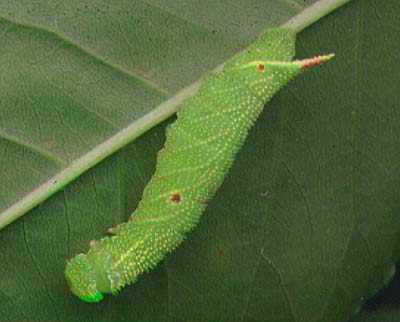Paonias myops, the Small-eyed Sphinx
Paonias myops
pay-OH-nee-usmmMY-ops
(J. E. Smith, 1797)
Sphinx

Paonias myops, Athol, Worcester County, Massachusetts,
June 10, 2008, courtesy of Dave Small.
This site has been created by
Bill Oehlke at oehlkew@islandtelecom.com
Comments, suggestions and/or additional information are welcomed by Bill.
TAXONOMY:
Family: Sphingidae, Latreille, 1802
Subfamily: Sphinginae, Latreille, 1802
Tribe: Smerinthini, Grote & Robinson, 1865
Genus: Paonias Hubner, [1819]
Species: myops (J.E. Smith, 1797)
|
MIDI MUSIC
......It's a Wonderful World......
copyright C. Odenkirk
ON.OFF
<bgsound src="world.mid" LOOP=FOREVER>
|
DISTRIBUTION:
Paonias myops, the Small-eyed Sphinx (wingspan 52-69 mm), ranges from south
eastern Canada to Florida westward almost to the Pacific Coast. It is fairly common here on
Prince Edward Island, with males coming in to lights much more frequently than females.


Paonias myops, Peterborough, Ontario, June 10, 2005, courtesy of Tim Dyson.
FLIGHT TIMES:
Paonias myops flies from June through September in eastern Canada and is
especially abundant in New Brunswick.
In New Jersey the Small-eyed Sphinx is double-brooded.
In Louisiana there are four broods at roughly 50 day intervals with the
first brood eclosions peaking at the end of March.
ECLOSION:
Paonias myops moths emerge from pupae formed in small subterranean chambers.
SCENTING AND MATING:
Small-eyed Sphinx females call in the night flying males with an airbourne pheromone
emitted from a gland at the posterior of the abdomen.Both sexes rest with wings parallel to
the resting surface, with the upper lobes of the hindwings protruding above the forewings. The lower abdomen of the
male (right) arcs
upward toward the head, while the abdomen of the female hangs strait down on a vertical surface. |
 |
EGGS, LARVAE, PUPAE:
Pale green eggs are
deposited on hostplants foliage and
this sphinx will oviposit readily on the insides
of brown paper sandwich or grocery bags.Wild cherry species are
the favorites as larval
foodplants, but eggs will also be deposited on birches and other
forest trees. To the right a second instar larva rests on pin
cherry.
The "red heart" marking readily identifies this species. There are varying degrees to the amount of red along the sides of the larvae. |

Scan by Bill Oehlke |

Paonias myops Ettrick, Trempealeau County, Wisconsin,
courtesy of Don Severson

Paonias myops Ettrick, Trempealeau County, Wisconsin,
courtesy of Don Severson
Return to U. S. A. Table
Return to Main Sphingidae Index
Return to Smerinthini Tribe
Visit Paonias myops, Chaseburg, Vernon County, Wisconsin, June 1, 2011, May 3, 2012, Dan Jackson
Visit Paonias myops, Rock Island Preserve, Linn County, Iowa, June 12, 2011, Tom Jantscher
Visit
Paonias myops, Bradford County, Florida, courtesy of
Edith Smith.
Visit Paonias myops male, Orleans County, Vermont, July 10, 2009, courtesy
of Jane Housewright.
Visit Paonias myops female (reared), May 24, 2011, courtesy of Ian Miller.
Visit Paonias myops, Shimek S.F., Croton Unit East, Lee County, Iowa, June 22, 2013, July 20, 2013;
Thomas Jantscher
Use your browser "Back" button to return to the previous page.
This page is brought to you by
Bill Oehlke and the
WLSS. Pages are on space rented from Bizland. If you would like
to become a "Patron of the Sphingidae Site", contact Bill.
Please send sightings/images to Bill. I will do my best to respond to
requests for identification help.
Enjoy some of nature's wonderments: Saturniidae cocoons. Cocoons of these
giant silkmoths are for sale in fall and winter. Large, beautiful moths emerge in the spring and summer.
 | 
Show appreciation for this site by clicking on flashing butterfly to the left.
The link will take you to a page with links to many insect sites. |








